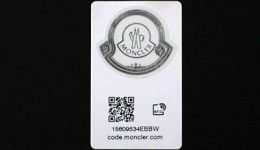
Brand equipment such as Moncler uses NFC to combat fakes
[ad_1]
On April 4th, the light luxury down jacket brand Moncler once again declared war against fakes. Starting from this spring and summer series, Moncler’s products will be equipped with a new anti-counterfeiting system.
Every Moncler product will have a built-in smart chip device, printed with a brand logo, a unique string of codes and a QR code for each product, and an NFC (Near Field Communication) logo.
Consumers can use apps that support reading QR codes and NFC codes to uniquely identify the identity information of each product.

The NFC chip device is based on the radio frequency identification technology RFID. This new technology has also been used in recent popular mobile payments, such as Apple Pay, Samsung Pay, and Android Pay.
NFC code operation is simpler, but this new technology is more dependent on the support of hardware devices, so there are also QR codes as an alternative. You can get a series of product codes by scanning the QR code, and then check the product information on the Moncler website.
Moncler also stated in the statement that this new anti-counterfeiting system is more direct, simple and efficient, will increase product transparency and traceability, create more sense of security for consumers, and thus close the relationship with them.

To configure chips for products, Moncler is not the first brand to come up with this idea. Last month, Ferragamo also said to configure chips for their shoes and bags, which sounds like they use similar technology. Ferragamo also said that they are not only to fight counterfeiting, but also to allow products to circulate smoothly in the secondary market.
In the fight against fakes, the two brands are also in the same trench.
Last year, Ferragamo destroyed or seized 100,000 counterfeit products, mainly from China and illegal sales on the Internet.
According to WWD, Moncler reported and shut down 50 fake domain names registered by impersonation this year. According to Reuters, in November last year, it sued a Chinese manufacturer for infringement and was awarded RMB 3 million in compensation. Moncler called this victory the first highest statutory compensation under China’s new trademark law. judgment.
Of course, all brands are united in the fight against fakes.
According to the paper, many brands under the luxury goods group Kering, including Gucci, YSL and Balenciaga, filed a lawsuit against Alibaba and its platform merchants in the United States, accusing Alibaba of deliberately “tolerating” a large number of counterfeiters selling illegally around the world commodity. Then reached a settlement, saying that it would cooperate with Alibaba to “fight counterfeiting.” Only less than a year later, he filed a lawsuit against Ali for the same reason. The lawsuit alleges that Ali and its affiliated entities “provide online platform advertisements and other necessary services required by counterfeiters.”
Even Burberry, which is stationed on Tmall, has a large part of the reason to combat fakes on this platform.
The latest chip anti-counterfeiting system allows consumers to distinguish between genuine and imitation products simply and quickly, but this is not all that solves the problem. On the one hand, it is the imbalanced pricing strategy of foreign brands in the world that has induced unofficial sales channels such as Daigou, which is the root cause of consumers accidentally buying fake products; on the other hand, the consumer behavior of buying fake products is not all Because it is impossible to distinguish the authenticity of the product. Many people know the fakes but still buy them because they believe this can really maximize the “price-performance ratio”.
If Moncler’s anti-counterfeiting system is effective enough, consumers can easily and reliably carry out authenticity inspections, then the counterfeit goods circulating in gray channels will naturally be hit, and this move will certainly help buyers and purchasing sellers to build closer trust. .
[ad_2]




